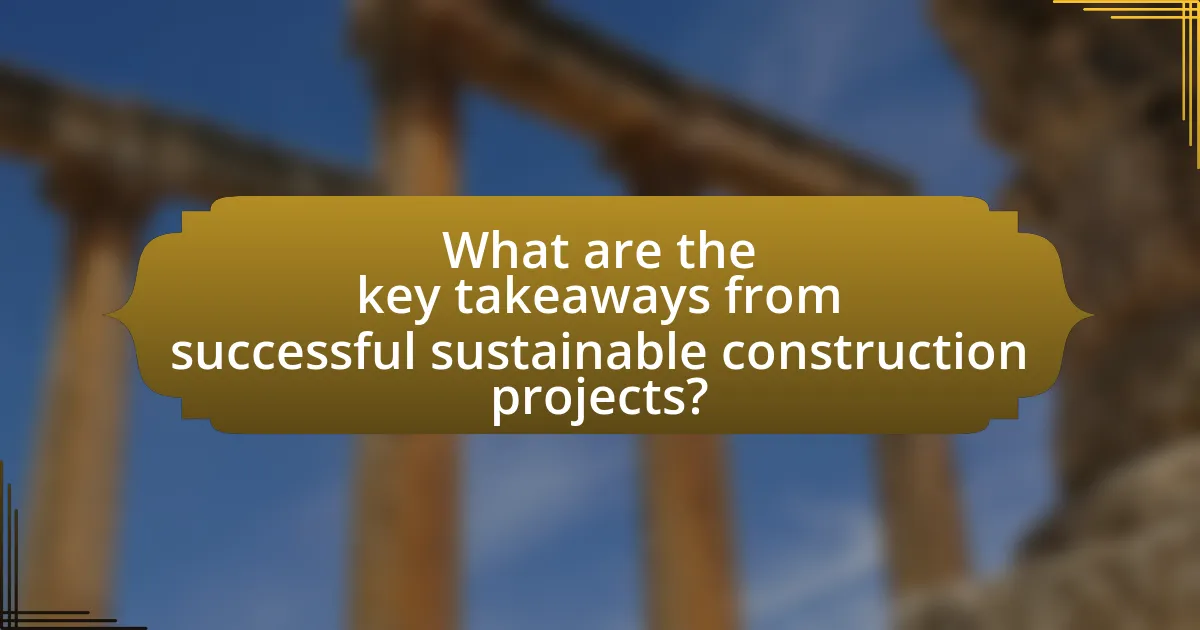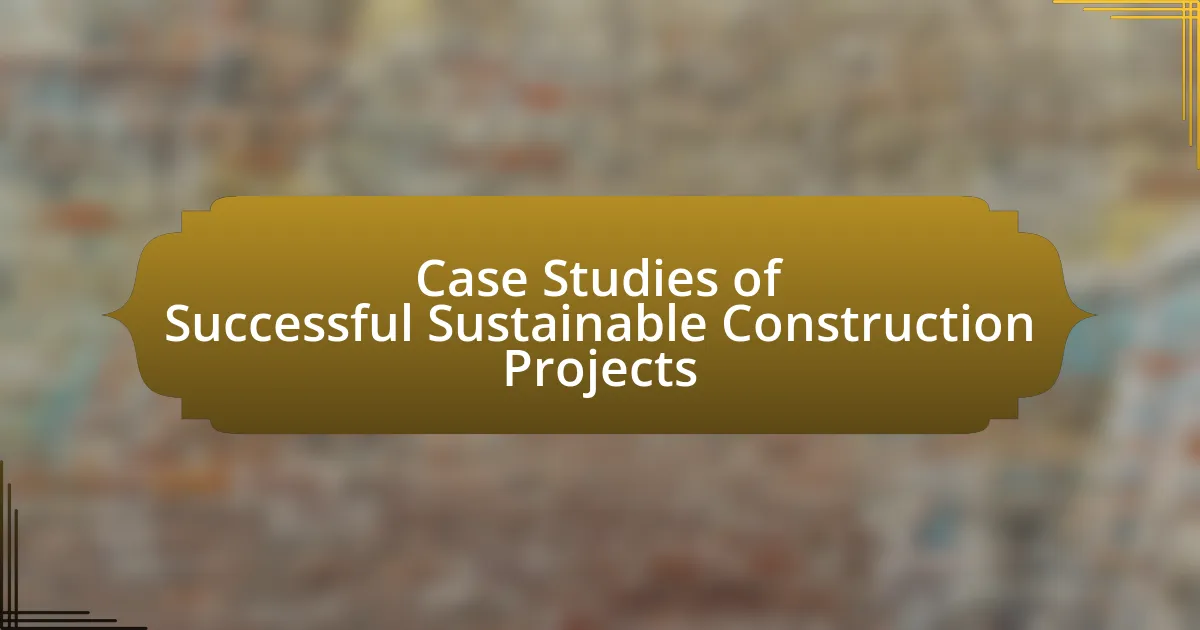The article focuses on case studies of successful sustainable construction projects, highlighting notable examples such as the Bosco Verticale in Milan, the Bullitt Center in Seattle, and One Central Park in Sydney. It examines how these projects demonstrate sustainability through innovative practices, including the use of recycled materials, energy-efficient systems, and water conservation techniques. The criteria for defining successful sustainable construction projects are outlined, along with evaluation methods such as Life Cycle Assessment and sustainability certifications. Additionally, the article discusses the challenges faced during implementation and the lessons learned, emphasizing the importance of stakeholder engagement and the application of best practices for future projects.

What are Case Studies of Successful Sustainable Construction Projects?
Case studies of successful sustainable construction projects include the Bosco Verticale in Milan, Italy, which features vertical forests that improve air quality and biodiversity. This project incorporates over 9,000 trees and 20,000 plants, significantly reducing energy consumption for heating and cooling. Another example is the Bullitt Center in Seattle, USA, designed to be the greenest commercial building in the world, achieving net-zero energy and water usage through solar panels and rainwater harvesting systems. Additionally, the One Central Park in Sydney, Australia, integrates green roofs and walls, enhancing urban biodiversity and reducing heat island effects. These projects exemplify innovative approaches to sustainability in construction, demonstrating measurable environmental benefits and energy efficiency.
How do these case studies demonstrate sustainability in construction?
These case studies demonstrate sustainability in construction by showcasing innovative practices that reduce environmental impact and enhance resource efficiency. For instance, projects that utilize recycled materials, such as reclaimed wood or repurposed steel, significantly lower the carbon footprint associated with new material production. Additionally, the implementation of energy-efficient systems, like solar panels and green roofs, exemplifies how buildings can minimize energy consumption and promote biodiversity. Furthermore, water conservation techniques, such as rainwater harvesting and greywater recycling, illustrate effective management of water resources, contributing to overall sustainability in construction.
What criteria define a successful sustainable construction project?
A successful sustainable construction project is defined by its ability to minimize environmental impact, enhance social equity, and ensure economic viability. These criteria include efficient resource use, such as energy and water conservation, the incorporation of renewable materials, and the implementation of waste reduction strategies. Additionally, successful projects prioritize the health and well-being of occupants through improved indoor air quality and access to natural light. Economic sustainability is achieved by ensuring that the project is financially feasible and provides long-term value. Research indicates that projects adhering to these criteria not only reduce carbon footprints but also enhance community resilience and promote sustainable development goals.
How are these projects evaluated for sustainability?
Projects are evaluated for sustainability through a comprehensive assessment framework that includes criteria such as environmental impact, resource efficiency, social equity, and economic viability. This evaluation often utilizes tools like Life Cycle Assessment (LCA), which quantifies the environmental impacts associated with all stages of a project’s life, from material extraction to disposal. Additionally, sustainability certifications, such as LEED (Leadership in Energy and Environmental Design) or BREEAM (Building Research Establishment Environmental Assessment Method), provide standardized metrics for assessing a project’s sustainability performance. These frameworks are supported by empirical data and case studies demonstrating the effectiveness of sustainable practices in reducing carbon footprints and enhancing community well-being.
Why are case studies important in understanding sustainable construction?
Case studies are important in understanding sustainable construction because they provide real-world examples of successful practices and outcomes. These documented instances illustrate how sustainable construction techniques can be effectively implemented, showcasing the benefits such as reduced environmental impact, cost savings, and improved building performance. For instance, the Bullitt Center in Seattle, recognized as one of the greenest commercial buildings, demonstrates how innovative design and sustainable materials can lead to significant energy efficiency and a minimal carbon footprint. By analyzing such case studies, stakeholders can learn from both successes and challenges, enabling better decision-making and fostering the adoption of sustainable practices in future construction projects.
What insights can be gained from analyzing these case studies?
Analyzing case studies of successful sustainable construction projects reveals critical insights into effective practices and strategies. These insights include the identification of innovative materials and technologies that enhance energy efficiency, as demonstrated by projects that utilize renewable energy sources, such as solar panels and green roofs. Furthermore, the case studies highlight the importance of stakeholder collaboration, showcasing how partnerships among architects, engineers, and local communities lead to more sustainable outcomes. Evidence from these projects indicates that integrating sustainability into the design and construction phases not only reduces environmental impact but also results in long-term cost savings, as seen in buildings that achieve LEED certification. Overall, these case studies provide a roadmap for future projects, emphasizing the need for a holistic approach to sustainability in construction.
How do case studies influence future sustainable construction practices?
Case studies influence future sustainable construction practices by providing real-world examples of successful implementation and innovative solutions. These documented projects showcase effective strategies, materials, and technologies that have led to reduced environmental impact and enhanced efficiency. For instance, the Bullitt Center in Seattle, recognized as one of the greenest commercial buildings, demonstrates how integrating renewable energy sources and sustainable materials can achieve net-zero energy consumption. Such case studies serve as benchmarks, guiding future projects by illustrating best practices and quantifiable outcomes, thereby encouraging the adoption of sustainable methods across the construction industry.

What are some notable examples of successful sustainable construction projects?
Notable examples of successful sustainable construction projects include the Bosco Verticale in Milan, Italy, and the Bullitt Center in Seattle, USA. The Bosco Verticale, or “Vertical Forest,” consists of two residential towers that incorporate over 9,000 trees and 20,000 plants, significantly improving air quality and biodiversity in an urban setting. The Bullitt Center is designed to be the greenest commercial building in the world, featuring a solar array that produces more energy than it consumes, rainwater harvesting systems, and composting toilets, achieving a Living Building Challenge certification. These projects exemplify innovative approaches to sustainability in architecture and urban planning.
How did these projects achieve their sustainability goals?
These projects achieved their sustainability goals through the implementation of energy-efficient technologies, sustainable materials, and innovative design practices. For instance, many projects utilized renewable energy sources such as solar panels and wind turbines, which significantly reduced their carbon footprint. Additionally, the use of recycled and locally sourced materials minimized environmental impact and supported local economies. Furthermore, projects often incorporated green building certifications, such as LEED, which provided a framework for measuring sustainability performance and ensuring adherence to best practices. These strategies collectively contributed to the successful attainment of sustainability objectives in construction projects.
What innovative techniques were employed in these projects?
Innovative techniques employed in successful sustainable construction projects include the use of prefabrication, green roofing, and advanced energy modeling. Prefabrication allows for components to be manufactured off-site, reducing waste and construction time, as evidenced by the Eco-Cycle project, which reported a 30% reduction in material waste. Green roofing systems, such as those implemented in the Bosco Verticale in Milan, enhance biodiversity and improve energy efficiency by providing natural insulation. Advanced energy modeling techniques, utilized in the Bullitt Center in Seattle, enable precise energy consumption predictions, leading to a net-zero energy building that produces as much energy as it consumes. These techniques collectively contribute to the sustainability and efficiency of modern construction practices.
What materials were used to enhance sustainability?
Recycled materials, bamboo, and rammed earth were used to enhance sustainability in construction projects. Recycled materials, such as reclaimed wood and recycled steel, reduce waste and lower the demand for new resources. Bamboo is a rapidly renewable resource known for its strength and versatility, making it an eco-friendly alternative to traditional timber. Rammed earth, which utilizes natural soil, provides excellent thermal mass and reduces the carbon footprint associated with conventional building materials. These materials collectively contribute to sustainable construction practices by minimizing environmental impact and promoting resource efficiency.
What challenges did these projects face during implementation?
The projects faced several challenges during implementation, including budget constraints, regulatory hurdles, and stakeholder engagement issues. Budget constraints often limited the scope of sustainable practices that could be integrated, as seen in the Green Building Council’s report highlighting that 30% of projects exceeded initial financial projections. Regulatory hurdles, such as obtaining necessary permits and adhering to local building codes, delayed timelines and increased costs, as documented in the National Institute of Building Sciences’ findings on sustainable construction. Additionally, engaging stakeholders, including community members and investors, proved difficult, leading to conflicts and misaligned expectations, which was noted in a study by the American Society of Civil Engineers that found 40% of projects faced significant delays due to stakeholder disagreements.
How were these challenges overcome?
The challenges in sustainable construction projects were overcome through innovative design solutions, effective stakeholder collaboration, and the implementation of advanced technologies. For instance, projects utilized green building materials and energy-efficient systems to address environmental concerns, while engaging local communities and experts to ensure that the projects met both ecological and social needs. Evidence of success can be seen in the LEED-certified buildings, which demonstrate reduced energy consumption by up to 30% compared to conventional structures, showcasing the effectiveness of these strategies in overcoming challenges.
What lessons were learned from these challenges?
The lessons learned from the challenges faced in sustainable construction projects include the importance of stakeholder engagement, the necessity of adaptive project management, and the value of integrating innovative technologies. Stakeholder engagement ensures that all parties, including the community and regulatory bodies, are aligned with project goals, which can mitigate conflicts and enhance project acceptance. Adaptive project management allows teams to respond effectively to unforeseen issues, as seen in projects that successfully navigated regulatory changes or supply chain disruptions. Furthermore, integrating innovative technologies, such as energy-efficient materials and smart building systems, has proven to enhance sustainability outcomes and reduce long-term operational costs. These lessons underscore the need for a holistic approach in sustainable construction to overcome challenges and achieve project success.

What are the key takeaways from successful sustainable construction projects?
Key takeaways from successful sustainable construction projects include the integration of energy-efficient technologies, the use of sustainable materials, and the emphasis on community engagement. Energy-efficient technologies, such as solar panels and high-performance insulation, significantly reduce operational costs and carbon footprints, as evidenced by the Bullitt Center in Seattle, which generates more energy than it consumes. The use of sustainable materials, like recycled steel and low-VOC paints, minimizes environmental impact and promotes health, demonstrated by the Edge in Amsterdam, which utilizes innovative materials to enhance sustainability. Lastly, community engagement fosters local support and ensures that projects meet the needs of residents, as seen in the redevelopment of the Eastside Community Center in Tacoma, which involved extensive community input to create a facility that serves diverse local needs.
How can these takeaways be applied to future projects?
The takeaways from case studies of successful sustainable construction projects can be applied to future projects by implementing best practices in design, materials selection, and project management. For instance, utilizing renewable materials and energy-efficient technologies, as demonstrated in projects like the Bullitt Center in Seattle, can significantly reduce environmental impact and operational costs. Additionally, incorporating stakeholder engagement strategies, as seen in the construction of the Bosco Verticale in Milan, fosters community support and enhances project outcomes. These applications not only promote sustainability but also align with industry standards and regulations, ensuring compliance and long-term viability.
What best practices can be derived from these case studies?
Best practices derived from case studies of successful sustainable construction projects include the integration of energy-efficient technologies, the use of sustainable materials, and the implementation of effective waste management strategies. Energy-efficient technologies, such as solar panels and high-performance insulation, have been shown to significantly reduce energy consumption, as evidenced by projects that achieved up to 50% energy savings compared to traditional buildings. The use of sustainable materials, like recycled steel and bamboo, not only minimizes environmental impact but also enhances the durability of structures, with studies indicating that buildings using these materials have longer lifespans. Effective waste management strategies, including recycling and reusing construction debris, have been proven to reduce landfill contributions by over 30% in various projects, demonstrating a commitment to sustainability.
How can stakeholders ensure the success of sustainable construction initiatives?
Stakeholders can ensure the success of sustainable construction initiatives by actively engaging in collaborative planning and decision-making processes. This involvement allows stakeholders to align their goals with sustainability objectives, ensuring that environmental, social, and economic factors are integrated into project designs. For instance, studies show that projects with stakeholder collaboration, such as the Bullitt Center in Seattle, achieved a 75% reduction in energy use compared to conventional buildings, demonstrating the effectiveness of inclusive strategies. Additionally, stakeholders should prioritize the use of sustainable materials and technologies, as evidenced by the construction of the Bosco Verticale in Milan, which incorporates green walls to improve air quality and biodiversity. By fostering partnerships, investing in training, and adhering to sustainability standards, stakeholders can significantly enhance the outcomes of sustainable construction initiatives.
What practical steps can be taken to implement sustainable construction practices?
To implement sustainable construction practices, builders should prioritize the use of eco-friendly materials, energy-efficient designs, and waste reduction strategies. Utilizing materials such as recycled steel, bamboo, and low-VOC paints can significantly reduce environmental impact. Energy-efficient designs, including passive solar heating and high-performance insulation, can lower energy consumption by up to 30% according to the U.S. Department of Energy. Additionally, adopting waste reduction strategies, such as recycling construction debris and minimizing material waste, can divert up to 90% of waste from landfills, as demonstrated by successful projects like the Bullitt Center in Seattle. These steps collectively contribute to a more sustainable construction process.

Leave a Reply